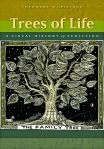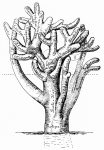By Vincent Burke, executive editor
Here is the recipe for science book success: One part brilliant scientist with odd interests, one part great story that has never been told, one part incredible visuals that amaze everyone who views them, one part editor looking for something different to add to his mix of titles.
Let’s start with the last part—that’s me, Vince Burke, the kid from Lackawanna, NY, who loved science enough to get a Ph.D. in it, and loved books enough to leave research and become an editor.
Now to the first part—that’s Ted–oops, make that Dr. Theodore W. Pietsch, world expert on four things (maybe more): 1) an odd group of fish that no one ever sees, 2) Peter Artedi (a guy some people think might have been murdered by Linnaeus), 3) the history of science, and 4) drawings that sketch out the history of life on earth.

That leads us to the second and third parts. You have to see the “Trees of Life” that Ted has found. They are beautiful, thought provoking, historically important, and, bound together in his book (cleverly titled Trees of Life) tell a compelling story. Honestly—if you buy one science book this year, you won’t be sorry if this is the one you purchase. [And it can be yours for 40% off the list price through the end of the year via our holiday book sale – ed.]
So, why believe a boy from Lackawanna? You don’t need to. Science Magazine (which is so picky about the reviews it publishes I once heard an editor call it “the best place I’ve never seen my books reviewed”) highlighted it for its 300,000 plus readers. National Geographic recently sang its praises, in an article written by preeminent science writer Carl Zimmer. And Brain Pickings—the blog no one with a keyboard can resist—called it one the 10 best science books of the year (and, not so incidentally, one of the 10 best history books of 2012 as well).
The list goes on: from science journals such as Taxon and Systematic Biology, to library journals such as Choice, to The Guardian’s Birdbooker Report and websites including Shelf Awareness and Dispersal of Darwin (yes, there is a site called that!).
Like any (honest) editor, I didn’t know if the recipe would work until I tasted it. But once I had the book in my hands I thought: “Now, this could just be one of those books.” Turns out that it is.




